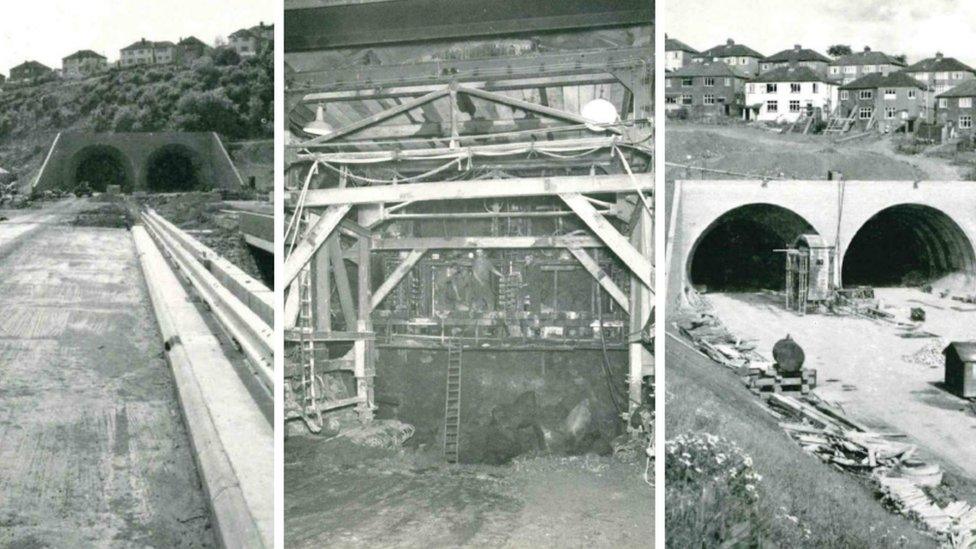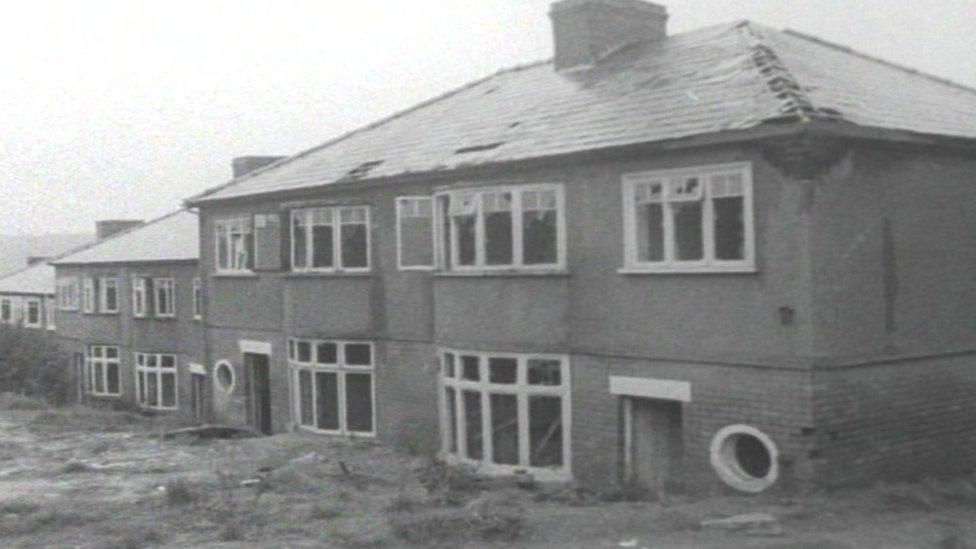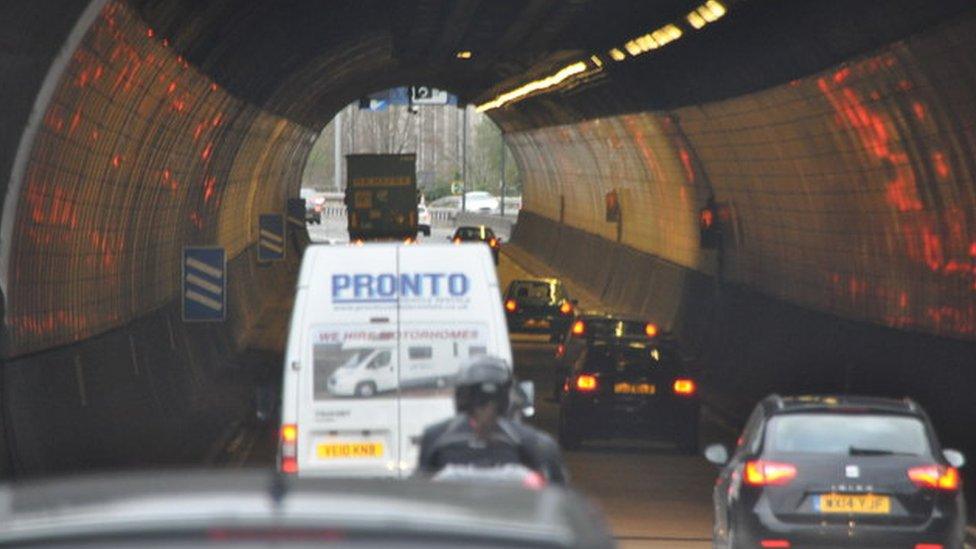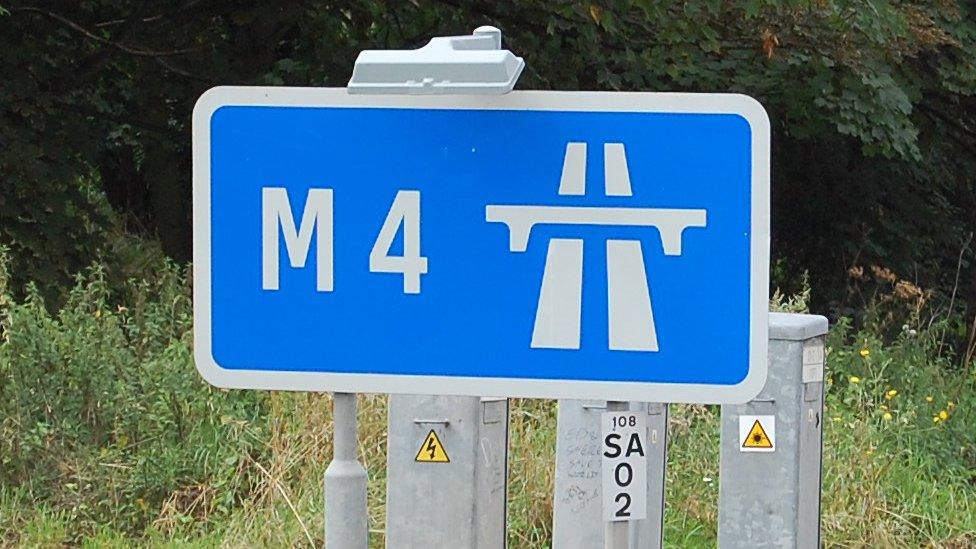'Unique' Brynglas tunnels celebrate 50th birthday
- Published

They are one of Wales' most notable landmarks and on Friday the Brynglas tunnels are celebrating their 50th birthday.
While they are as well known as Caerphilly Castle and Cardiff's Principality Stadium, the M4 tunnels at Newport are renowned for all the wrong reasons.
But the notorious traffic bottleneck, once described by a former prime minister as a "foot on the windpipe of the Welsh economy", is also a feat of engineering and a motorway milestone in the UK.
The 360m (1,180ft) twin bore, two lane holes are significant because they were the first tunnels to be built on the British motorway network.
"The tunnels are not only of historical importance to Wales, they opened up social opportunities that we struggle to comprehend today," said Brian Hawker, assistant engineer on the Brynglas tunnels.
"When you're stuck in a traffic jam, you don't tend to appreciate the historic significance of the tunnel you are sitting in. It is an engineering marvel and helped the economic and social well-being of south Wales overnight."
The new M4 prepares to open around Newport
The £3m tunnels project - led by engineer Sir Owen Williams, chief engineer on the old Wembley Stadium, the Spaghetti Junction, and the Newport bypass - relieved the "crippling congestion" in a stroke when it opened on 5 May 1967.
"Its success has ultimately led to its biggest criticism," said Mr Hawker.
"Built to accommodate 30,000 vehicles a day, it is nearing breaking point and traffic data says its the UK's most-congested stretch of motorway away from the M25.
"The opening of the Brynglas tunnels bypass around Newport and the Severn Bridge opened up the area, as getting around Newport and going to England was previously like going on safari," added Mr Hawker, the Welsh Office's former head of roads and major projects.

Brynglas tunnels facts
First tunnels on the UK motorway network
It is the only tunnel on the M4
The tunnels are between junction 25 and junction 26 on the M4
There is a 50mph speed limit on the westbound tunnel following a lorry fire in the tunnel in 2001

He added: "Now it took 30 minutes and gave relief to Newport and gave quick access to schools, work and hospitals.
"The tunnels and the ease of movement around south Wales raised people's expectations, but the tunnels have outgrown their capacity as demand for road travel rose beyond all recognition."
The Welsh Government have acknowledged the current M4 at Newport is "not fit for purpose" and said it wants to build a £1bn M4 relief road, external to ease congestion.
A six-lane motorway to the south of Newport was first proposed as far back as 1991 and only now is a public inquiry being held into building a 15-mile (24km) relief road.
Bryn Parry, who has been in the same home on Brynglas Road all of his life, lived above the tunnel construction site
The benefit of hindsight shows today's problems could have been averted way back in the early 1960s.
One plan was to make a cut in the hill, but the Monmouthshire railway company line - between Newport and Pontypool on the east side of Crindau Ridge - meant the tunnel was the only option at the time.
Mr Hawker said: "The shame is Dr Beeching's cuts closed that line in 1963, half way through construction.
"With a little planning, some of the subsequent traffic problems could have been averted as we would have built the road through the hill."
M4 motorway: Building Newport's Brynglas Tunnels
The initial M4 route - from the Severn Bridge to Tredegar Park in Newport, now junction 28 - was strategically located through the middle of Newport to generate traffic numbers to justify its existence to government.
Then, Newport was unique as, despite being a relatively small town, it had five motorway junctions to attract local traffic to use the M4 as a bypass and not a long-haul route, the intention of a motorway.
The line of the Newport bypass was dictated by the need to open the south Wales valleys, towns like Pontypool, Newbridge, Risca and the new town of Cwmbran, according to Mr Hawker.
Loss of leeks
"These were important strategic areas of economic resurgence following the demise of heavy industry. The development of a new, vibrant valleys economy was absolutely dependant on good road access," he said.
But the UK-first was not without its challenges and it cost one local his prized vegetables.
"I remember a representation to our site office from a house owner on the hill, who said he was concerned because he had just lost his prized leeks," said Mr Hawker.

Houses on Brynglas Hill above the tunnels had to be demolished following movement during construction
"They were due to be shown at a horticultural show the following week," he said.
"It turned out that there was diagonal movement in the rock and that couldn't be controlled. Engineers found his house was cracked from top to bottom and had to be demolished.
"As a result of that movement, a dozen families had to be moved from their homes, put into a hotel while the necessary engineering work was carried out."
- Published5 May 2017

- Published8 September 2016
